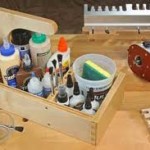Adhesives For Woodworking
 Although there are approximately 1,500 adhesive products manufactured in the United States, less than a dozen are suitable for woodworking. Before getting into the individual types of adhesives, it might be helpful to know how glue bonds wooden parts together. It is helpful to understand a little about the chemical makeup of wood and how an adhesive interacts with these components during the bonding process. Wood is a complex mixture of organic chemicals and water.
Although there are approximately 1,500 adhesive products manufactured in the United States, less than a dozen are suitable for woodworking. Before getting into the individual types of adhesives, it might be helpful to know how glue bonds wooden parts together. It is helpful to understand a little about the chemical makeup of wood and how an adhesive interacts with these components during the bonding process. Wood is a complex mixture of organic chemicals and water.
About 95 percent of a board consists of cellulose, hemicelluloses and lignin, which form the structural matrix of wood and give it its rigidity, strength and elasticity. The remaining five percent contained in dry wood is composed of tannins, essential oils, resins, gums, coloring agents and sugars. This chemical mixture of extractives is responsible for wood’s smell, color and decay resistance. Unfortunately, extractive in some resinous woods, such as teak and rosewood can interfere with the gluing process.
Once an adhesive is applied to adjacent wood surfaces and the pieces are clamped up, the structural elements of the wood of wood are linked together by the bonding process. First, the liquid adhesive is absorbed into the wood and its polymer molecules intermingle with the structural fibers of wood. Then, the adhesive’s polymer molecules coalesce or come together, surround the structural fibers and harden, mechanically interlocking the fibers.
Thermosetting glues such as epoxy, urea formaldehyde and resorcinol cure by a chemical reaction, usually after two components have been mixed, while thermoplastic adhesives, such as yellow and white glues cure by evaporations. Once either type of glue is dry, the think layer of cured adhesive between the two wood surfaces acts like a bridge holding the boards together.
Exclusive $20 Discount on 16,000 woodworking plans and projects. Activate your discount now: TedsWoodworkingDiscount
Find us on Facebook
Categories
- Adhesives For Woodworking
- Beds
- Drills
- Hand Tools
- Hardwoods
- How to
- News
- Power Tools
- Routers
- Safety
- Safety and Health
- Sanders
- Saws
- Shed
- Sheds
- Softwoods
- wood joints types
- Woodwork Machineries
- Woodworking
- woodworking business
- Woodworking Crafts
- Woodworking Equipment
- Woodworking Plans
- Woodworking Projects
- Woodworking Tools
- Woodworking Videos
FREE PLAN!
Download your free Shed Plan here.
